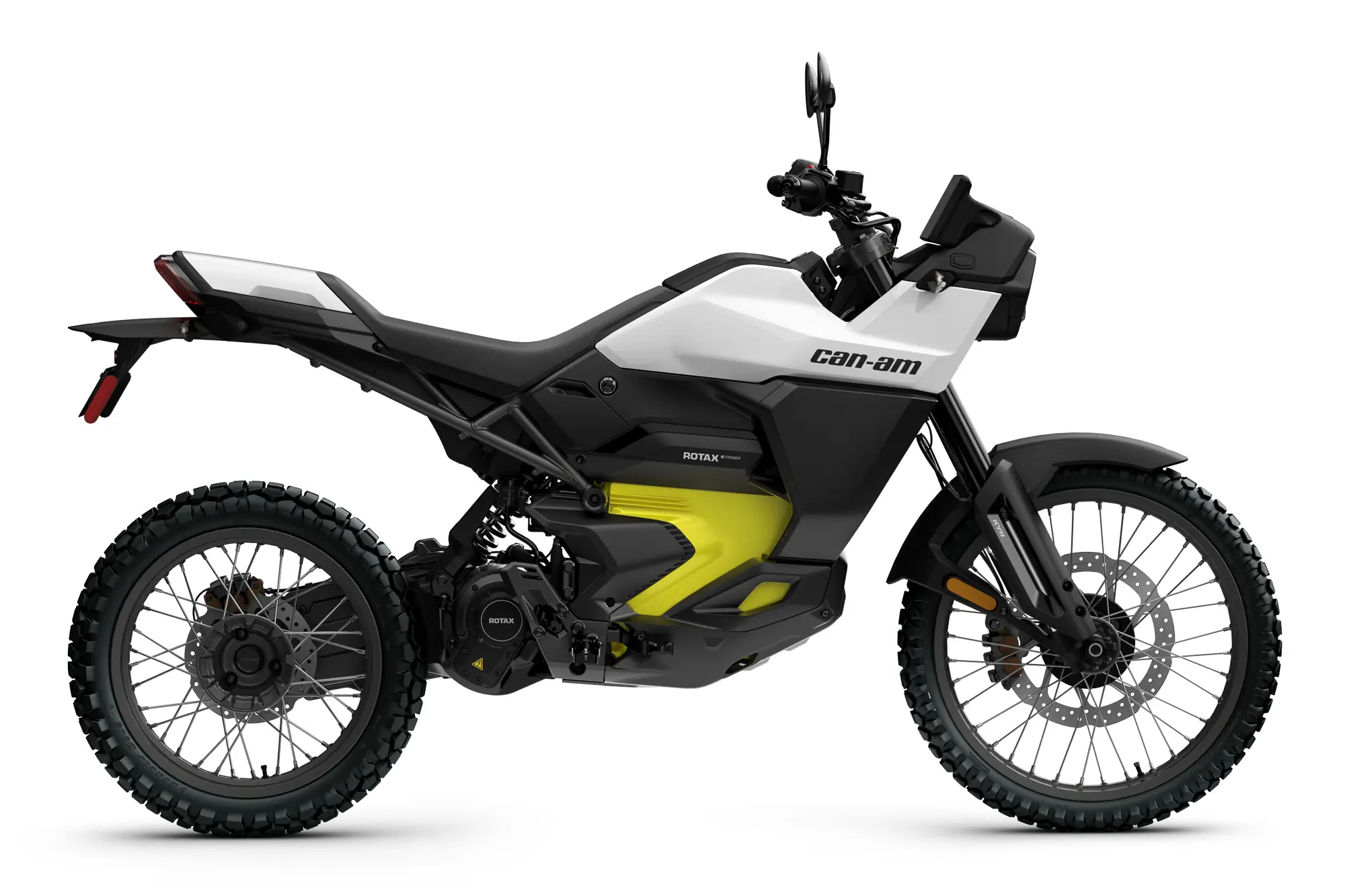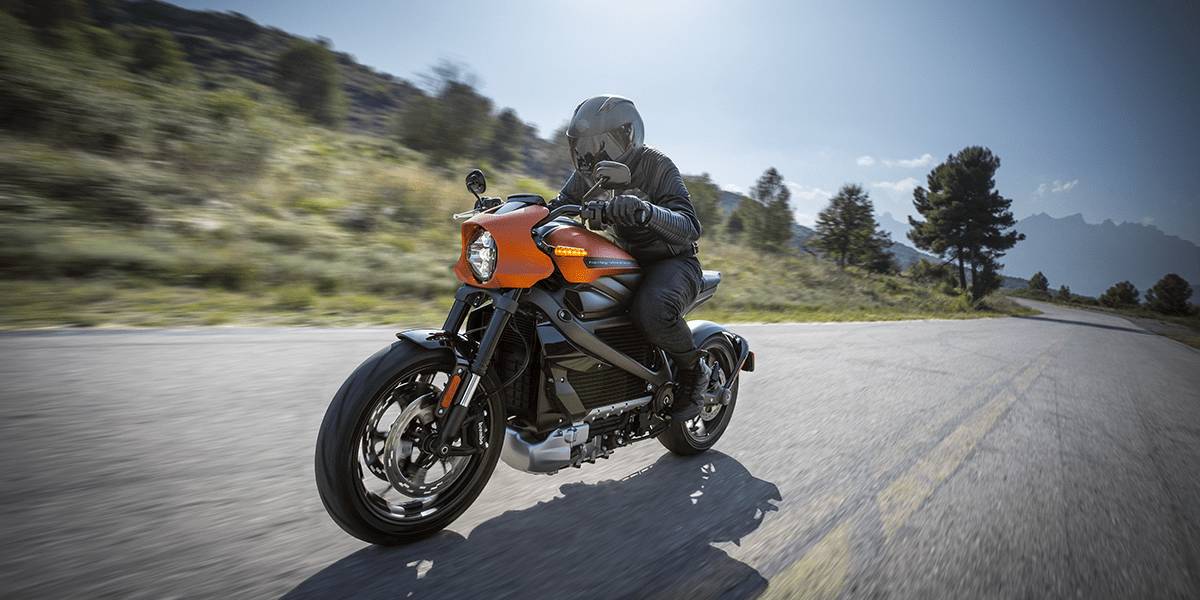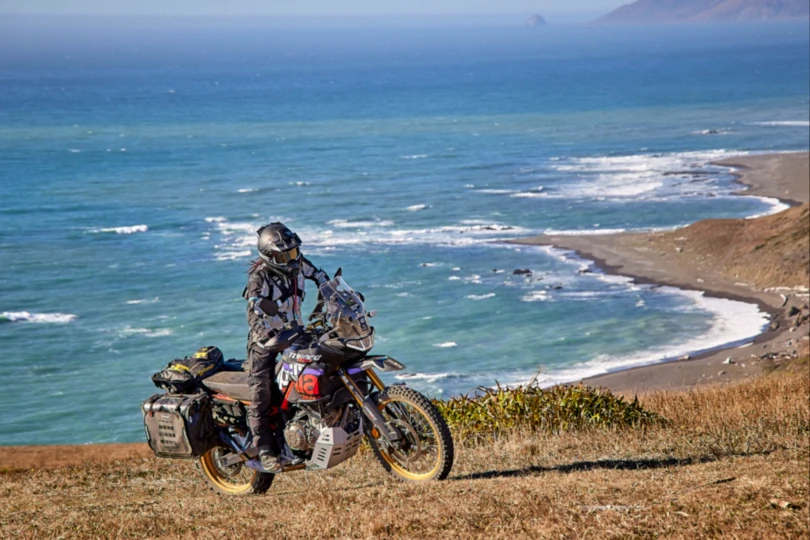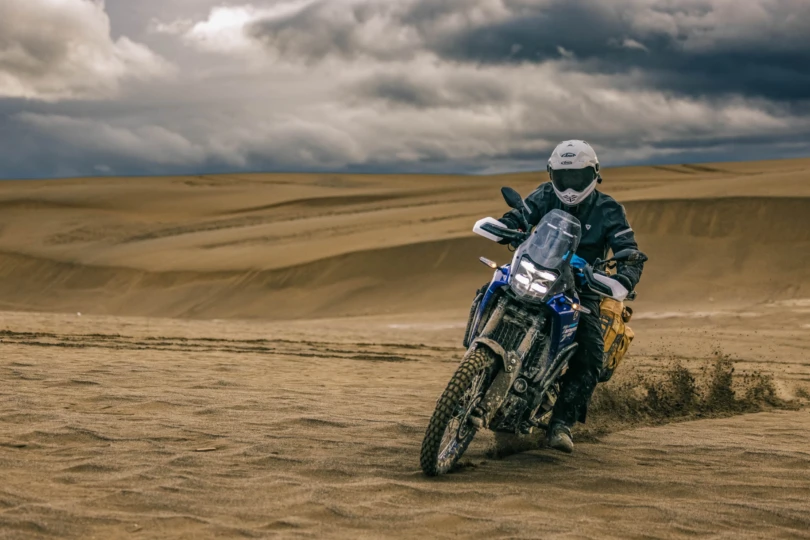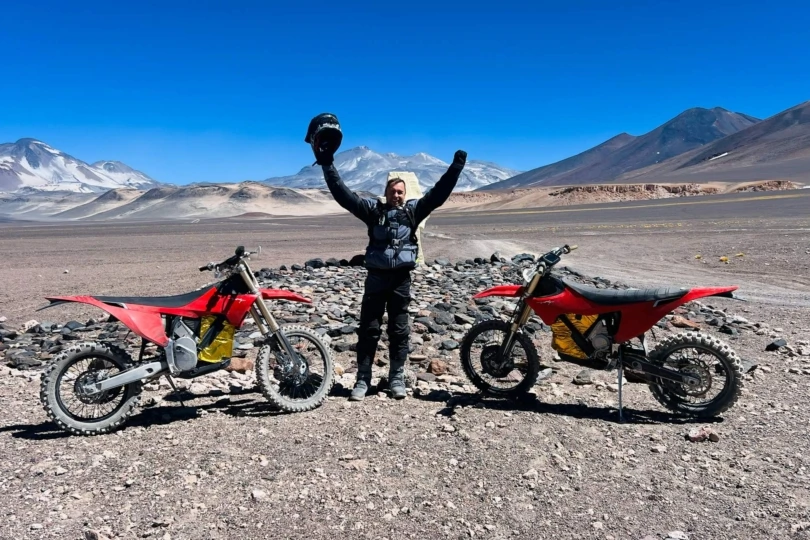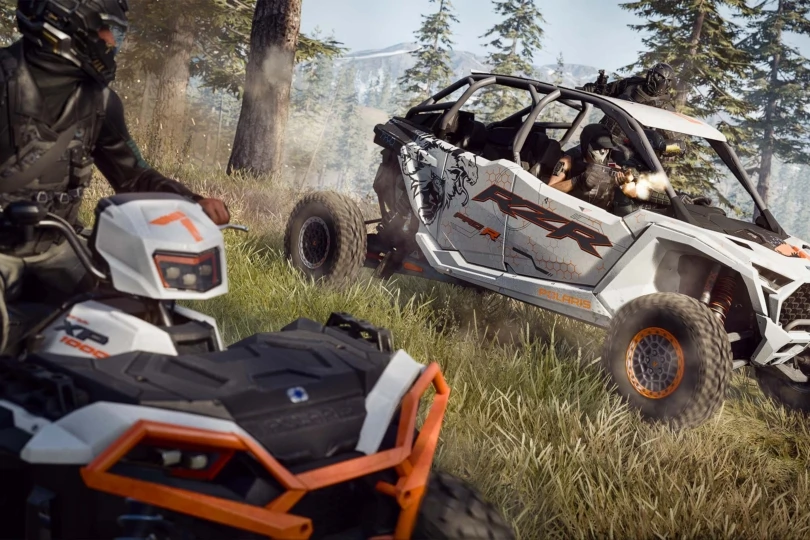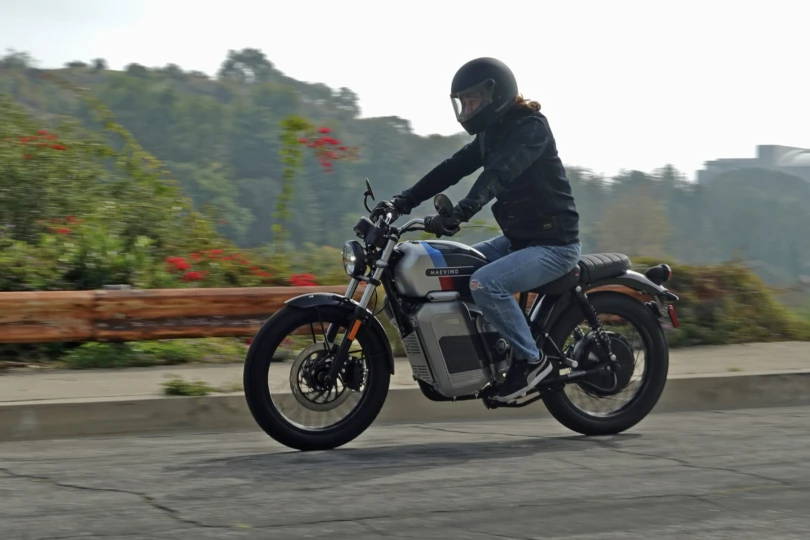I am excited by the promise of electric dirt bikes. Silently ripping through the woods or around a motocross track (in the middle of town!) without the noise and exhaust of internal combustion engines would eliminate many negatives associated with powersports. The heaps of torque common in electric powerplants also check the “plus” box.
Being an older rider, I cringe at some things about electric motorcycles. The lack of a clutch and transmission makes me wonder about controlling all that torque. What will the left side of my body do? And, well, the silence, as great as it is, leaves an acoustic hole. The sounds of a perfectly tuned four-stroke or two-stroke motorcycle have made me smile since I was a kid.
So, call me on the fence, but with an open mind. I took this position to an all-day outing on the Can-Am Origin that started in Austin, Texas. We meandered our way through downtown, blasted down freeways, and tried to get sideways on windy country roads. Eventually, our group reached a motocross park, where I rode the Can-Am Origin as hard as possible before hitting the tarmac again to return to Austin.
In short: The Can-Am Origin makes a stellar urban commuting motorcycle that can take you on a spirited jaunt on dirt roads or trails on the fringes of your urban jungle. In that capacity, Can-Am did an amazing job of integrating its electric powerplant into a bike that crushes the urban transportation game. But the lack of range limits its dual-sport or adventure-riding chops.
- Base price: $14,999
- Range: 90 miles city, 71 mixed
- Top speed: N/A
- Weight: 412 pounds
Pros
- Motor has incredible torque and acceleration
- Incredibly smooth ride, everywhere
- Chain case eliminates maintenance, damage, and noise
- Bike feels incredibly refined for a first run
Cons
- Limited range
- Limited suspension performance on dirt
- Very intrusive front ABS
Can-Am Origin Main Features
You can read up on many of the Can-Am Origin specifications in our original launch news.
Can-Am / BRP / Rotax PowerUnit Core
The star of the show was definitely the PowerUnit Core, which Can-Am borrows much from BRP’s electric snowmobiles. This tightly and neatly packaged unit consists of a Rotax-built electric motor (Rotax is also part of BRP), an 8.9 kWh battery pack, a DC to AC voltage converter, a power regulator, and a 6.6 kW sharing module.
All of this is liquid-cooled, with a pair of radiators flanking the front of the yellow-colored Transformers-like assembly. This liquid cooling is exclusive to Can-Am in the industry.
Also notable is the battery has a 5-year warranty, and the bike has a 2-year warranty.
Can-Am rates the motor at 47 horsepower, 53 pound-feet/72Nm of torque, and boasts a 0-60 mph time of 4.3 seconds.
Can-Am employs its PowerUnit Core as a stressed member of the Origin chassis, which is visibly the largest structure of the frame. I thought the Canadian brand did a stellar job with styling and fairings, as did many people in Austin; both the Origin and the Pulse street versions drew comments about how cool they looked.
Can-Am claims 90 miles of range in the city and 71 miles for combined highway and city driving. The brand also claims to charge from 20% to 80% in less than an hour on a level 2 charger. This relatively fast rate is possible, Can-Am says, because of the cooling of the battery. This allows a high rate of charging immediately instead of at a lower rate while the battery cools down.
Can-Am Chain Case

Another unique and interesting adjunct to the PowerUnit Core was the “chain case.” Can-Am immerses the chain in oil and completely encloses it. Not only does this render the final drive silent, but it also eliminates the downsides of a chain. There is almost no maintenance, it doesn’t throw lube all over the bike, and it’s protected from debris and damage.
The chaincase also employs an automatic chain tensioner, which reminded me of a cam chain tensioner in a car motor. This means zero chain tension adjustments.
The swingarm and chaincase assembly form a single-sided swingarm. I imagined it would make much quicker work of rear tire repairs that demanded dismounting the wheel.
I’m a dirt biker who marvels at suspension. The Can-Am chain case also revealed another design parameter that filled me with anticipation. The engineers leveraged the comparatively tiny size of the electric motor and reduction gear and placed it behind the swingarm pivot. The advantages of this aren’t apparent until you think about normal dirt bike suspension.
A cog behind the swingarm drives the chain, so the forces of the drive chain cannot influence rear suspension action. On a gas dirt bike, a countershaft sprocket in front of the swingarm pivot drives the chain.
The top and bottom runs of the chain engage with a larger rear sprocket, so tension on either affects the rear suspension. Accelerating usually makes the rear suspension squat down, while deceleration can extend it.
Dirt bike brands and riders do have a few workarounds, like a slipper clutch, but none of this is necessary with the Can-Am Origin drive chain configuration. The rear suspension can operate freely, independent of chain forces.
Kayaba Suspension
Can-Am didn’t try reinventing the wheel when it specified the suspension on the Origin. It went with a well-known and respected entity in the dirt bike world and shod the Origin with a Kayaba fork and shock. Both provide 10 inches of travel.
The forks offer no adjustment, while the shock has rebound adjustment.
And in a similar move, Can-Am chose Dunlop D605 dual sport tires. I was happy to see this rubber on the Origin, as many dual-sport bikes I’ve tested arrive with essentially street tires that have no business being on dirt. The D605 is another known entity and is one of the more capable DOT-approved dual sport tires.
Electronic Rider Assists
The Can-Am Origin has six different ride modes, each allowing adjustments of throttle response, ABS, and traction control. Normal, Sport, Rain, Eco, Off-road, and Off-road+ modes mix these characteristics in combinations that make the most sense in each scenario.
The Origin has two battery regeneration modes. When slowing down, the bike performs a “standard” passive battery regeneration. However, it also has an “active regeneration” mode. The rider actuates this mode by turning the throttle forward from the closed position, which decelerates the bike and recharges the battery at a much higher rate.
In a way, it’s another way of braking. I had never seen this in an electric motorcycle or e-bike before. Both the passive and active regeneration modes have three intensity settings that the rider can further adjust.
The video above covers all the Origin’s connectivity features, which include Apple CarPlay.
Reverse Gear
The Can-Am Origin also has a reverse gear. Holding the start button down activates it, and turning the throttle as usual causes the bike to power itself in the reverse direction.
The Can-Am Origin tips the scales at 412 pounds.
Can-Am Origin Ride Impressions
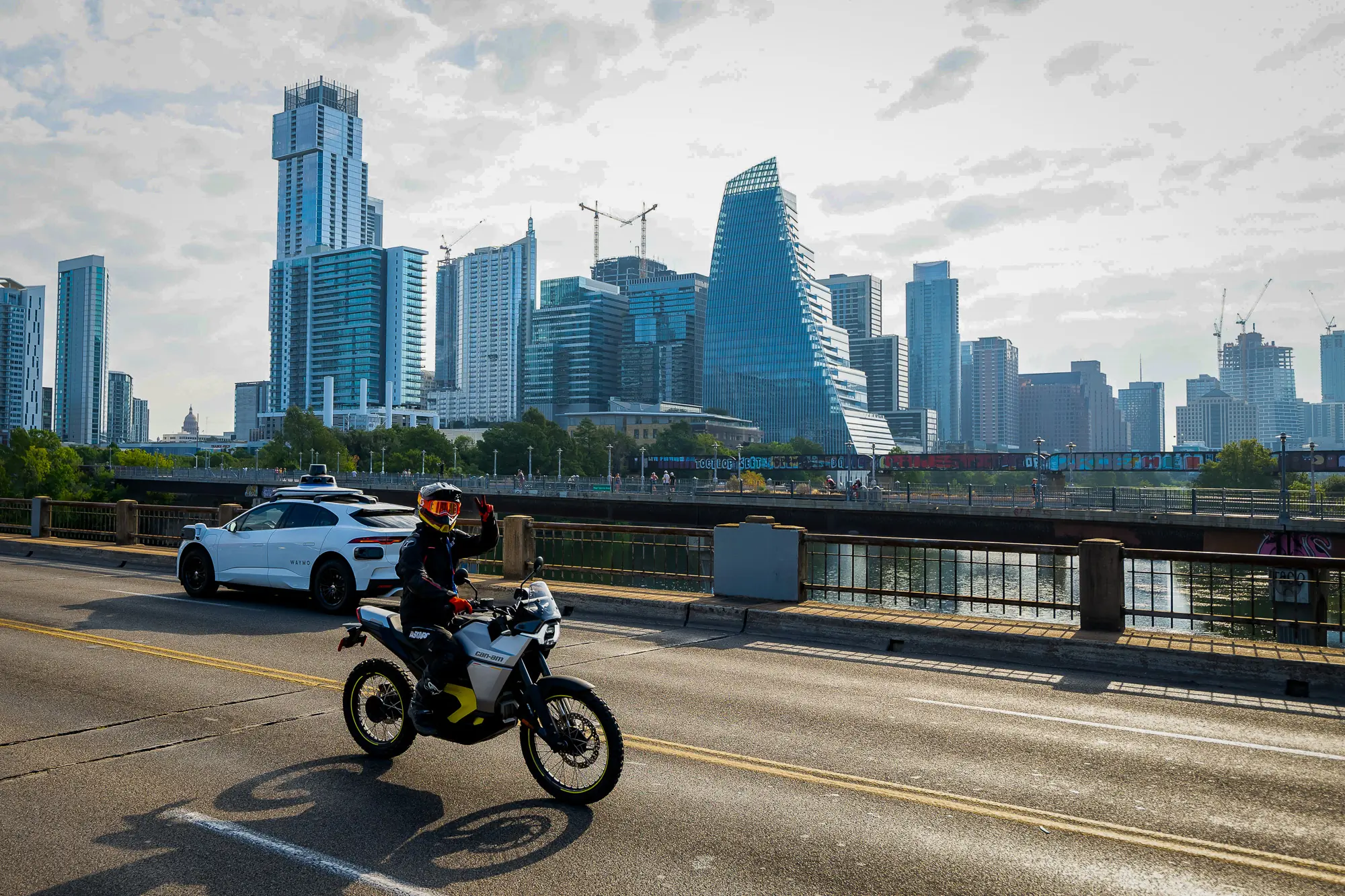
The Can-An Origin elicited all the traits you’d expect from an electric motorcycle. It was nearly silent, and there weren’t the usual noises an electric bike with a chain makes. The chain case eliminated the usual high-speed clack, which is usually the tone I associate with electric dirt bikes. The loudest sound was the air rushing through my helmet.
Overall, the electric motor response was what I expected in an electric vehicle. The diminutive Rotax motor delivered instant torque off a closed throttle and the resulting acceleration was amazing. The Origin delivered exhilaration from low-speed acceleration I’ve only felt with a powerful electric motor.
The Can-Am Origin was smooth in all aspects. Throttle response, chassis manners, and all the bits and bobs performed in a very refined manner.
Nothing was out of line; the quietness of the experience mated well with the electric motor’s output and suspension characteristics. Compared to a gas dirt bike, there was no comparison in terms of ride smoothness in all aspects.
In Town
We navigated from our downtown hotel through the heart of Austin. Right away, I noticed the lack of engine heat; it was Texas in the summer. I assume the motor will roast me at stoplights. But this wasn’t the case with the Origin. Nothing underneath me was cooking my body.
The next incredibly obvious thing was the effectiveness of the active regeneration mode. Twisting the throttle against resistance forward was a strange sensation at first, but the smooth braking action paid dividends.
Once I learned how the active regeneration responded, I rarely used the hydraulic disc brakes in the city. The fact that it was recharging the battery at a higher rate was an afterthought.
Another strange and pleasant sensation was the ability to chat with the rider next to me at stop lights without an in-helmet radio or shouting. It was also nice not to yell, “Thanks!” to all the motorists who commented without shouting on how cool the bikes were and how great it was that they were electric.
The instant torque delivered super-quick bursts of acceleration when I needed it to shoot into gaps when traveling at typical in-town low speeds. But I realized that car drivers couldn’t hear a reviving motor, so I used extra caution. On the freeways leaving Austin, the bike easily reached 90 mph before I got scared about getting a ticket.
Country Twisties
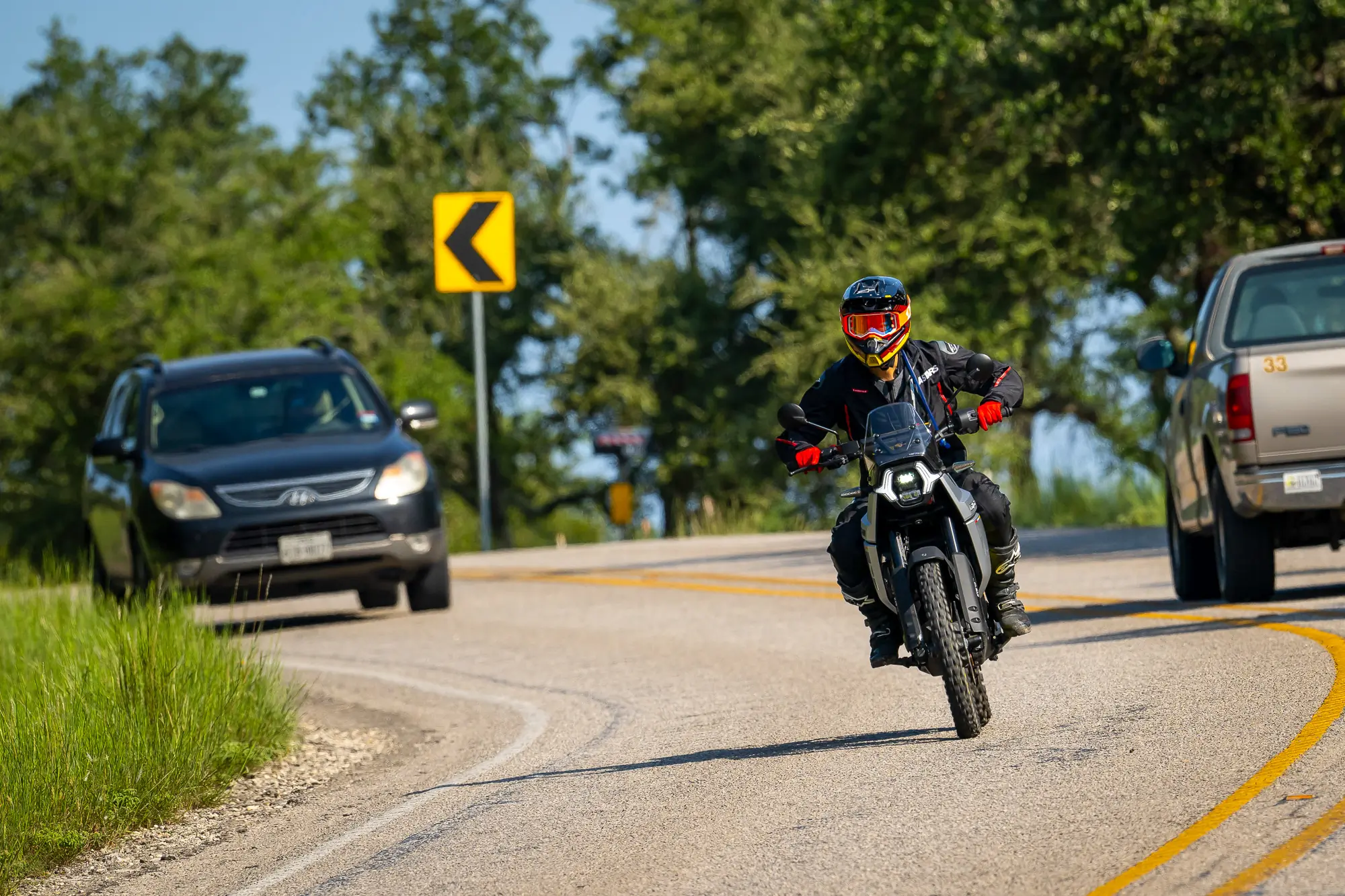



The windy and hilly Texas Hill Country two-lane farm-to-market roads provided a great backdrop to show how fun an electric powerplant on a bike could be. The Rotax motor’s instant torque and smooth acceleration (and smooth deceleration) made quick and fun work of the snake-like sections of the chip seal.
I felt a direct connection between my right wrist and the amount of power that went through the rear tire’s contact patch. I couldn’t be ham-fisted as the temperatures soared and the blacktop got slippery. The motor was plenty capable of overpowering the rear tire, and I was glad that I had traction control a few times when I got too giddy.
Speaking of tires, the Dunlop D605 proved itself to me once again. Despite the deep tread pattern, both front and rear tires felt smooth on the tarmac for dual-sport rubber. And as I’ll explain later, they functioned as well as a DOT-approved tire could on a bike like this.
Even on pavement, the disconnection between drive chain forces and the rear suspension was apparent. The shock stayed in the correct range of stroke and freely moved in that range, regardless of how hard I was punching it or slowing down.
The fork, however, tended to move too easily in the midstroke when hard on the brakes. It needed more hold-up power, in my opinion, even on the street.
The initial bite of the brakes was a little soft for me, but I got used to it quickly. The power modulation was easy to manage and felt linear in progression. Nothing surprised me, and the binders never fell short.
The ergonomics of the Can-Am Origin fit my 5’11” frame well while on the streets. The seat height was easily manageable, especially for a dual-sport or adventure bike, for my 32-inch inseam.
Can-Am Origin in the Dirt
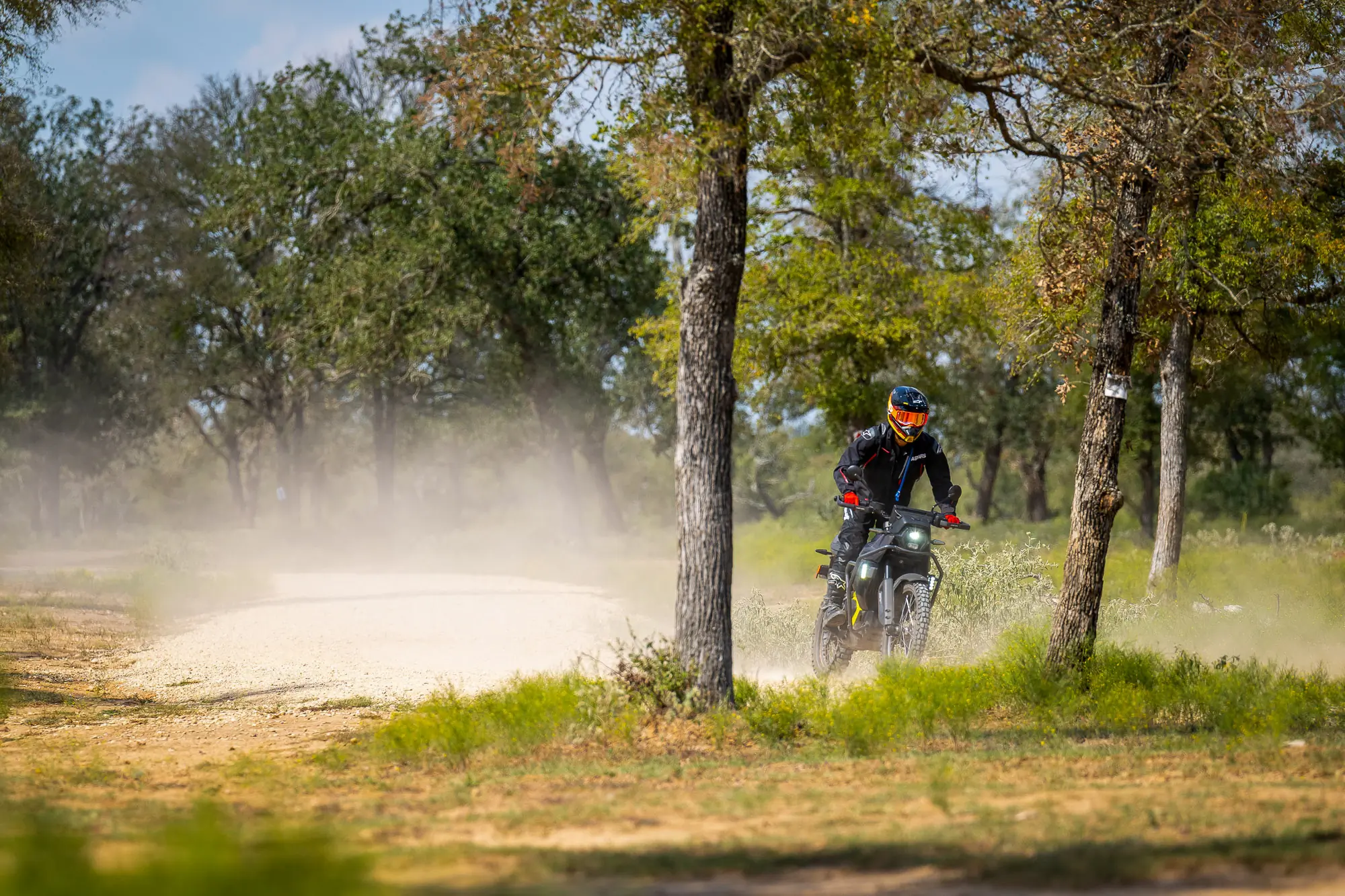



I’m a dirt biker at heart, so this is when I pushed the Can-Am Origin to both of our limits. Our group meandered to a motocross park, where the owners chopped out two separate woods loops.
The slightly rolling terrain had a layer of soft, dry, fine dirt on top of the hardpack, which is challenging for any bike. But especially so for a dual-sport bike on DOT-approved rubber powered by an electric motor.
After so many hours on pavement, I felt so much better standing on the pegs and moving about the chassis, which I had to do in an almost exaggerated way because of the Origin’s relative heft compared to a motocross bike.
Can-Am staff suggested I leave the Origin in Normal mode to start riding the loops. But one corner in, I switched it to off-road as the traction control and ABS were far too intrusive. I couldn’t at all approach a turn at any rate of speed or grab the brakes nearly as hard as usual, even with the dry conditions.
Very quickly, I progressed to Off-road+ mode and turned the rear ABS off. I couldn’t toggle the front ABS off.
I got up to speed very quickly on the Origin; the chassis felt balanced front to rear, and there weren’t any large offbeat handling traits. It rode like a smaller adventure bike to me. It was heavy, with a lot of weight high, and limited suspension capacity compared to a motocross or woods bike. I didn’t expect it to be either, but the electric motor was plenty capable of both.
The low-end torque, especially in the dry and dusty conditions, required careful throttle management and a lot of body jockeying to translate into traction and acceleration. The torque available could easily overpower the low amount of traction on hand. I really wanted two things: track prep and lower tire pressures, but neither was on tap.
But the more laps I rode, the more I got it under control. The motor wasn’t the weak point at all. It, by far, was the most fun part about the Origin when off-road.
It was really, really hot. The motor never reduced power, as some have in similar conditions. The liquid cooling really did work. The Rotax motor always delivered maximum power.
The front suspension blew right through the midstroke but didn’t bottom out frequently. The nonadjustability was a real bummer, as I really needed more damping and spring rate to hold it up better.
The rear shock performed better for me than the fork. I didn’t touch the adjustable rebound (the only adjustable valving). Nothing about the shock limited the bike the way that it was.
For a dual sport bike weighing 400+ pounds, I felt it did OK. It didn’t bottom often, the rebound control was adequate, and it moved through the travel smoothly and predictably. I have no doubts that my feeling about the rear suspension was partially due to its separation from drivetrain forces.
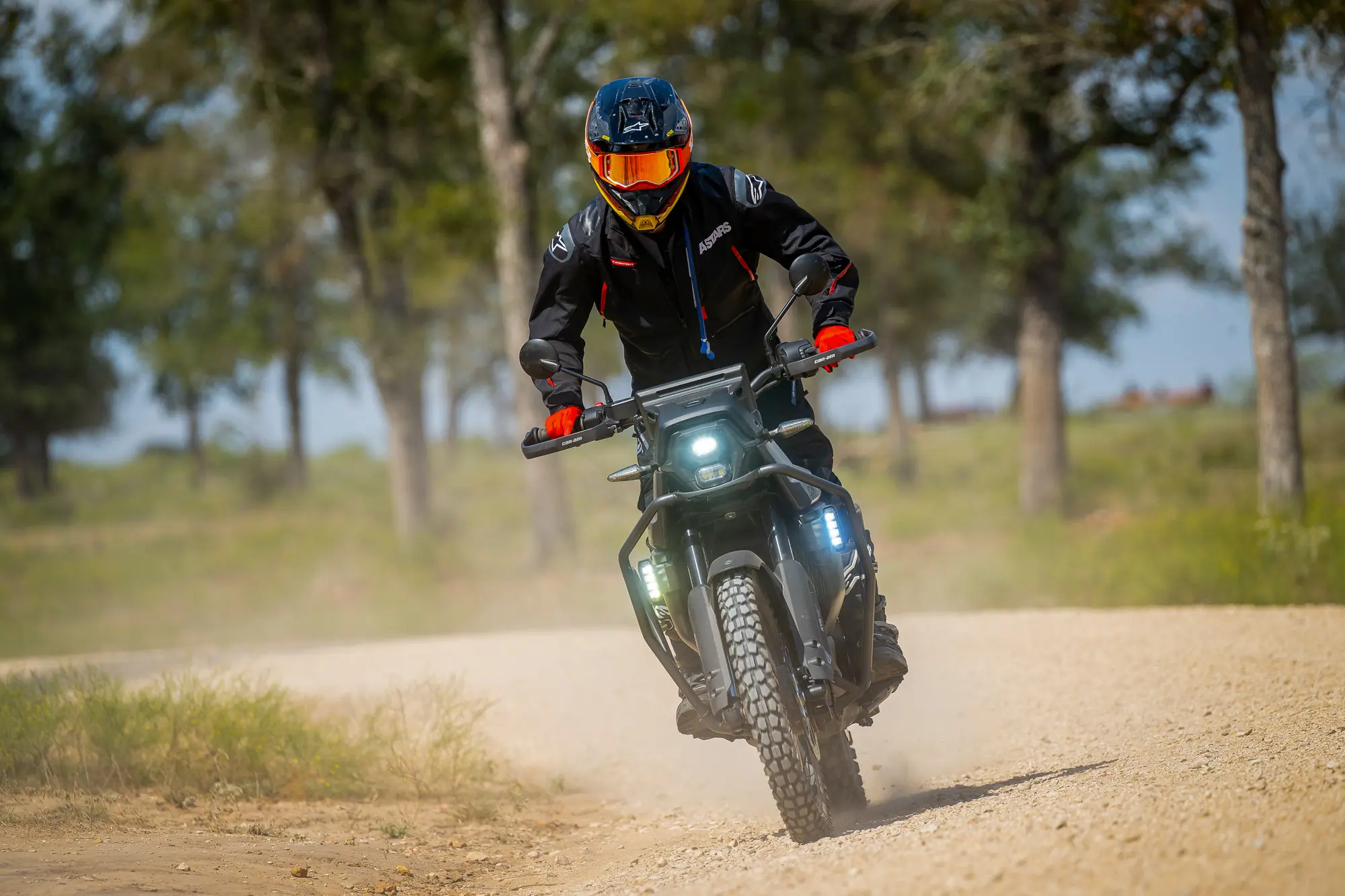



What did hold me back quite a bit was the front ABS. It was really intrusive, even in the Off-road+ mode. It was akin to riding with a front brake that faded in power just when I needed it.
I would approach a turn, standing in a neutral position, bike upright, applying both brakes evenly, and not locking the wheels. As I approached the turn and increased braking, the front would sign off as the ABS kicked in. I never got to the point of leaning the bike over.
I overshot so many turns that otherwise would have been fine. And I never got used to how hard the ABS would cut in. I didn’t crash because of it, but I did get into the weeds at turn entries quite often due to my lack of front brake power.
Also, the handlebar position that was fine on the streets was far too inward for the dirt. The bars felt like they were in my lap when I got on the “tank” in turns, which was great for me.
But standing and rowing forward to accelerate or get weight off the back of the bike proved uncomfortable and difficult. I really wanted offset bar clamps so I could move the bars more forward in the triple clamp.
I will add that I rode the Can-Am Origin as hard as the conditions allowed. And not once was I not smiling. It was hot, it was dry, and I rode right up to the point where I was going to have heat exhaustion. I didn’t want to stop. The motor and bike were that fun in the dirt.
The Elephant on the Bike
I had a lot of fun, mostly because of the motor characteristics, on the Origin, both on-road and off-road. I could have ridden all day on either — well, no, I couldn’t. This was an electric motorcycle, and like all of the others, the range was limited, very much so.
I never made it to the 90-minute mark with more than 10 miles left in the “tank.” My actual range was about 60-70 miles, which roughly agreed with the claimed mixed range. On the dirt, riding as hard as I could, an hour killed almost all the range.
With this range, as fun as the riding was, there was little dual-sporting or adventure riding possible. Our group had charging support at every stop to make our all-day adventure possible.
If you lived in the urban jungle, you might have enough range to hit a trail on the edge of town, do a 1-hour spirited trail ride, and barely make it home. You might have range anxiety the whole time you were on that trail, though, if you weren’t 100% familiar with where it went and how much “fuel” you use to complete it.
The Can-Am Origin very much looks like an adventure or larger dual-sport bike. But to me, it’s a super high-performance urban commuter with a touch of dual-sport riding chops. And if you look at it from this angle, it does it really well. But it’s no adventure bike.
The range issue isn’t specific to the Can-Am Origin at all; there are larger electric motorcycles with more range, and there are smaller ones with less range. The current state of technology is the limiting factor.
Conclusions on the Can-Am Origin Electric Motorcycle
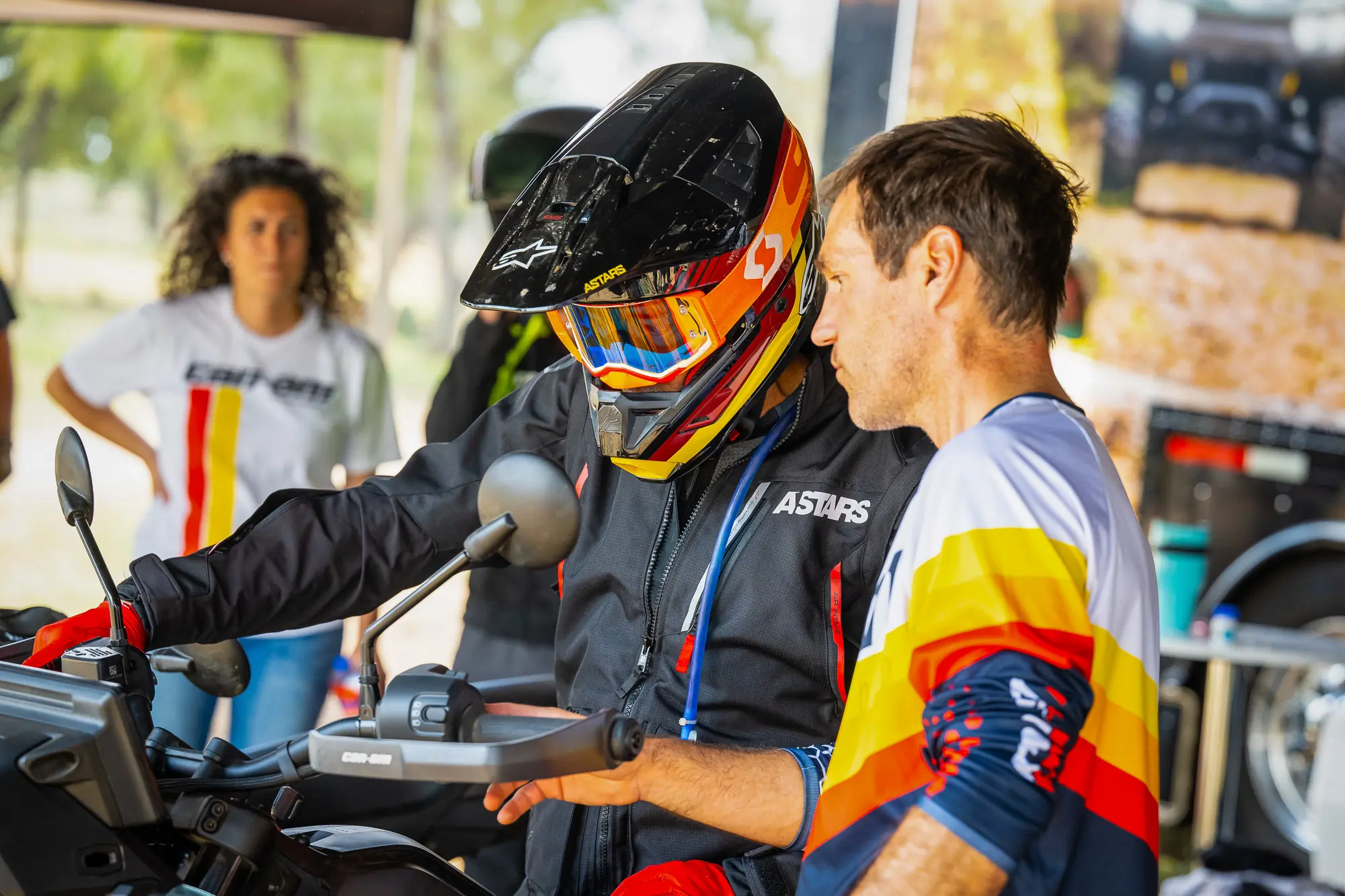



First, the PowerUnit Core and chaincase were amazing all around. The motor and drivetrain were so fun and performed remarkably well, especially given the brutal heat and gnarly conditions at the motocross park. They were a joy to ride on both the street and in the dirt.
The chassis did what I’d expect a 400+-pound dual-sport bike to do. It was fun on the twisty tarmac, and I was able to handle, with limits, the trails at the motocross park. It could do enough on the dirt that I had a lot of fun, and I didn’t want it to end.
The limited range is the big downside to the Can-Am Origin. But if you consider it an urban commuter that can handle mild trails, as long as those trails are close, then things start to stack up in the plus column.
I live about 45 minutes to an hour from Austin on dirt roads. Would I buy one at the $14,499 starting MSRP? That’s a hard call. I would love to rip it on my local dirt roads; the range works for that. But I couldn’t do a round trip to Austin without some range anxiety.
For me, I need the range to run to Austin and back. We just so happened to ride from downtown Austin to Wimberley, where I live. And I had 20 miles left. Almost, but not quite. But I’m confident the industry will get there.
Now, if Can-Am stuffed that PowerUnit Core into a motocross chassis, I’ll write that check on the spot! Please go back to your motocross roots, Can-Am!

